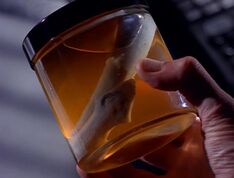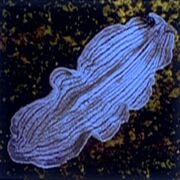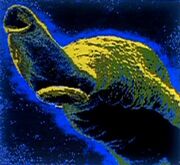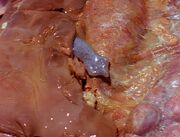
A flatworm (otherwise known as a flukeworm or less commonly as turbellaria) is a type of worm. Flatworms are what are known as obligate endoparasites. They live inside the host, entering the body through the ingestion of larvae or eggs. The turbellarian flatworms are free-living carnivorous scavengers, usually less than three centimeters in length, found in fresh and sea water. They are hermaphroditic with complex reproductive systems, capable of internal fertilization. Each worm has a scolex the parasite uses to attach itself to its host. Many species require more than one host to complete a life cycle and, incredibly, about forty million people are infected worldwide. Flukes are endemic in unsanitary conditions. It is unlikely that a single parasite would be able to kill a young man. All flukes and flatworms are capable of spontaneous regeneration.
Types[]
Turbellaria[]

Prosthecerus vittatus, a type of turbellarian flatworm.
The Turbellaria, like other flatworm classes, are usually very dorsoventrally flattened and the body shape varies from ovoid to elongate. Head projections are not uncommon. These may be in the form of tentacles, which vary in number and position, or in the form of lateral projections of the head called auricles. The auricies are frequently found in fresh water planarians. Coloration is largely in shades of black, brown, and gray, although some groups display brightly colored patterns. A few species are green, owing to the presence of symbiotic algae. Turbellarians range in size from microscopic species to species that are more than 60 cm in length, though most are only 10mm in length.
Turbellarians are mostly aquatic in nature and the majority are marine. A few of the pelagic species are bottom dwellers and habitate in the sand or mud. Fresh water forms, like the laboratory planarian known as Dugesia, live in lakes and ponds throughout the world, where they live in the vegetation at the bottom of lakes and ponds. Some species have even become terrestrial in nature. These species are confined to areas that are very humid, where they can hide beneath logs and leaf mold during the day and feed by night. These species come out at night to feed and mate. Land planarian, also known as giant Turbellarian, can reach a staggering 60 cm in length. Another example of a turbellarian flatworm is the Prosthecerus vittatus.
Flukeworms[]

Schistosoma mansoni, a type of flukeworm.
The flukes are parasitic flatworms. They lack cilla and, in place of cellular epidermis of their turbellarian ancestors, they have a thick cuticle secreted by the cells below the surface. This cuticle is highly resistant to enzyme action and thus an important adaptation to a parasitic way of life. Flukes characteristically possess many suckers, usually two or more, by which they attach themselves to the host. They have a two-branched cavity, which does not ramify throughout the body like that of the other Turbellarians. A large proportion of their bodies is occupied by reproductive organs, including two or more testes, an overy, and a long much-coiled uterus. An example of a flukeworm is the Schistosoma mansoni.
History[]

A flatworm Dana Scully found in human internal organs.
In 1994, Doctor Dana Scully, a Special Agent with the FBI, was shocked to discover a flatworm living inside the deceased body of a young male, who had actually been a Russian engineer named Dmitri aboard a cargo freighter but was still to be identified by Agent Scully. Scully found that the worm had apparently attached itself to the victim's bile duct and had been feeding off the liver. She subsequently placed this flukeworm in a jar.
Shortly after Scully first discovered the parasite, a sanitation worker from Newark, New Jersey - where Dmitri's body had been found - was dragged underwater and attacked in a sewer where he was attempting to carry out a maintenance task. He sustained a large bite mark as a result of the attack and experienced an unpleasant taste in his mouth that persistently lingered. While showering at home, he coughed up blood and another flukeworm. This parasite slithered down into the drain in the man's shower. The shape of the sanitation worker's wound suggested scolex attachment, but the injury was too large to have been made by a common flukeworm. The worker was later found dead in his home.
Scully's FBI partner, Special Agent Fox Mulder, showed the flatworm from Dmitri's body to a foreman at the Newark County Sewage Processing Plant, who identified it by stating, "It looks like a big old worm." He also admitted he was not surprised that the fluke had been extracted from the sewer as there was no way to tell what had been breeding down in the sewage system for the last one hundred years.
Scully, meanwhile, researched parasitic worms, including flatworms and tapeworms, as the flukeworm she had found was dissected and studied in a laboratory. She and Mulder ultimately came to the finding that both Dmitri's death and the attack on the sanitation worker was due to Flukeman, a sort of quasi-vertebrate human capable of spontaneous regeneration, a being that was the result of reproductive and physiological cross-traiting. Scully suggested that the fluke she had found could have been an incubating larva, one of many that Flukeman transmitted through his bite, and it was the study of the fluke larva's biology that informed the agents about the nature of Flukeman. (TXF: "The Host")